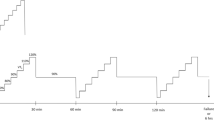Summary
The effect of prior submaximal exercise performed at two different pedalling frequencies, 60 and 120 rev · min−1, on maximal short-term power output (STPO) was investigated in seven male subjects during cycling exercise on an isokinetic cycle ergometer. Exercise of 6-min duration at a power output equivalent to 92 (SD 5)% maximal oxygen uptake\(\left( {\dot VO_{2max} } \right)\), whether performed at a pedalling frequency of 60 or 120 rev · min−1, reduced maximal STPO generated at 120 rev · min−1 to a much greater extent than maximal STPO at 60 rev · min−1. After 6-min submaximal exercise at 60 rev · min−1 mean reductions in maximal STPO measured at 120 and 60 rev · min−1 were 27 (SD 11)% and 15 (SD 9)% respectively, and were not significantly different from the reductions after exercise at 120 rev · min−1, 20 (SD 13)% and 5 (SD 9)%, respectively. In addition, we measured the effect of prior exercise performed at the same absolute external mechanical power output [236 (SD 30)W] with pedalling frequencies of 60 and 120 rev · min−1, Although the external power output was the same, the leg forces required (absolute as well as expressed as a proportion of the maximal leg force available at the same velocity) were much higher in prior exercise performed at 60 rev · min−1. Nevertheless, maximal STPO generated at 120 rev · min−1 was reduced after exercise at 120 rev-min−1 [20 (SD 13) %,P<0.05] whereas no significant reduction in maximal STPO was found after prior exercise at 60 rev · min−1. The present findings would suggest that exercise performed at 92 (SD 5)%\(\dot VO_{2max} \), whether at 60 or at 120 rev · min−1, selectively fatigues the faster fatigue-sensitive fibres resulting in a greater reduction in maximal STPO generated at 120 compared to 60 rev · min−1. The greater fatigue of maximal STPO generated at 120 rev · min−1 due to exercise performed at a power output of 236 (SD 30)W at 120 rev · min−1 compared to 60 rev · min−1 would suggest a relatively greater contribution of fast fatigue-sensitive fibres when higher movement frequencies and hence different muscle shortening velocities are used at this submaximal exercise intensity.
Similar content being viewed by others
References
Andersen P, Sjøgaard G (1976) Selective glycogen depletion in the subgroups of type II muscle fibres during intense submaximal exercise in man. Acta Physiol Scand 96:26A
Beelen A, Sargeant AJ (1991) Effect of fatigue on maximal power output at different contraction velocities in humans. J Appl Physiol 71:2332–2337
Beelen A, Sargeant AJ, Jones DA, de Ruiter CJ: Fatigue and recovery of voluntary and electrically stimulated force consequent upon dynamic exercise in humans. In: Sargeant AJ, Kernell D (eds) Neuromuscular fatigue. Academy series, Royal Netherlands Academy of Arts and Sciences. Elsevier, Amsterdam (in press)
Gollnick PD, Armstrong RB, Saubert IV CW, Piehl K, Saltin B (1972) Enzyme activity and fiber composition in skeletal muscle of untrained and trained men. J Appl Physiol 33:312–319
Gollnick PD, Piehl K, Saltin B (1974) Selective glycogen depletion pattern in human muscle fibres after exercise of varying intensity and at varying pedalling rates. J Physiol (Lond) 241:4557
Goldspink G (1978) Energy turnover during contraction of different types of muscle. In: Asmussen E, Jørgensen K (eds) Biomechanics VI-A. University Park Press, Baltimore, Md., pp 27–39
Hagberg JM, Mullin JP, Giese MD, Spitznagel E (1981) Effect of pedaling rate on submaximal exercise responses of competitive cyclists. J Appl Physiol 51:447–451
Löllgen H, Graham T, Sjøgaard G (1980) Muscle metabolites, force, and perceived exertion bicycling at varying pedal rates. Med Sci Sports Exerc 12:345–351
Sargeant AJ (1987) Effect of muscle temperature on leg extension force and short-term power output in humans. Ent J Appl Physiol 56:693–698
Sargeant AJ, Beelen gnA: Human muscle fatigue in dynamic exercise. In: Sargeant AJ, Kernell D (eds) Neuromuscular Fatigue. Academy Series, Royal Netherlands Academy of Arts and Sciences. Elsevier, Amsterdam (in press)
Sargeant AJ, Beelen A, Greig C (1991) Effect of movement frequency on EMG and leg forces during dynamic exercise in humans. In: Anderson PA, Hobart DJ, Danoff JV (eds) Electromyographical kinesiology. Elsevier, Amsterdam, pp 103–106
Sargeant AJ, Hoinville E, Young A (1981) Maximum leg force and power output of human muscle in maximal cycling exercise. J Appl Physiol 51:1175–1182
Suzuki Y (1979) Mechanical efficiency of fast- and slow-twitch muscle fibers in man during cycling. J Appl Physiol 47:263–267
Thomson JA, Green HJ, Houston ME (1979) Muscle glycogen depletion patterns in fast twitch fibre subgroups of man during submaximal and supramaximal exercise. Pflügers Arch 379:105–108
Vollestad NK, Blom PCS (1985) Effect of varying exercise intensity on glycogen depletion in human muscle fibres. Acta Physiol Scand 125:395–405
Vøllestad NK, Vaage O, Hermansen L (1984) Muscle glycogen depletion patterns in type I and subgroups of type II fibres during prolonged severe exercise in man. Acta Physiol Scand 122:433–441
Wendt IR, Gibbs OL (1974) Energy production of mammalian fast- and slow-twitch muscle during development. Am J Physiol 226:642–647
Widrick JL, Freedson PS, Hamill J (1992) Effect of internal work on the calculation of optimal pedaling rates. Med Sci Sports Exerc 24:376–382
Author information
Authors and Affiliations
Rights and permissions
About this article
Cite this article
Beelen, A., Sargeant, A.J. Effect of prior exercise at different pedalling frequencies on maximal power in humans. Europ. J. Appl. Physiol. 66, 102–107 (1993). https://doi.org/10.1007/BF01427049
Accepted:
Issue Date:
DOI: https://doi.org/10.1007/BF01427049




